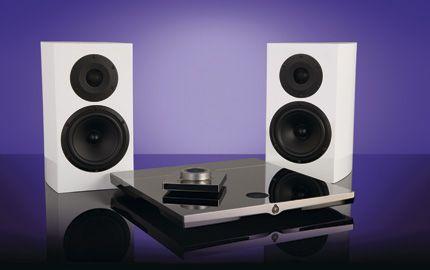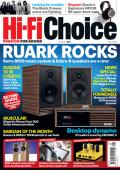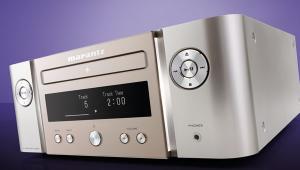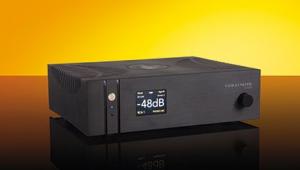Devialet Ensemble 120/GT1 SE - £6,290

Challenging hi-fi’s conventions has been at Devialet’s core since the French high-end maker launched its groundbreaking D-Premier amp back in 2010. Concepts including customising settings via an onboard SD card and online configurator, along with firmware releases ensuring your amp stayed up to date brought fresh thinking to long-term ownership.
Devialet’s range has since expanded into four models, and with each comes increased connectivity, power and configuration options. At the heart of all Devialet amps beats the same ADH (Analogue Digital Hybrid) amplification, which is a modern take on Quad’s Current Dumpers of yesteryear that uses analogue Class A voltage amplification working in parallel with digital Class D dumpers. All Devialet amplifiers also employ 24-bit/192kHz upsampling Texas Instruments PCM1792 DAC chips, developed into its proprietary Magic Wire circuit.
Sitting at the centre of our package is Devialet’s new entry-level 120 amp (£4,490 on its own), which morphed from the 110 model via new firmware, increasing its 110W output to 120W. Joining the 120 in our Ensemble is a pair of Devialet branded Atohm GT1 ‘Special Edition’ loudspeakers with matching white Atohm cables.
What sets this pairing apart from other bundles is the clever use of Devialet’s SAM tech, which tailors the amp’s supplied signal to match the spec and real-world behaviour of the speakers’ bass drivers.
The Atohm’s cabinets are formed via layers of 3mm MDF bonded together to achieve their curved sides. Each speaker houses a metal grille-covered soft-dome tweeter with copper-clad aluminium wire voice coils and neodymium magnets, alongside an alloy coned mid/bass driver using Atohm’s LDS peripheral suspension and a Kapton/Nomex coil former. The bass driver also sports a snug-fitting removable circular fabric cover.
In the flesh this is one cool combo to behold (providing you can keep fingerprints at bay). The amp shares the same dark chrome chassis as its 200 stablemate, that’s milled from a single block of aluminium with a sliding cable-hiding cover at its rear. You can even wall mount it vertically!
Its physical controls extend to just a logo-shaped power button, which joins a porthole-like digital screen providing a window into the amp’s working world, displaying volume and selected input. The minimalist theme continues with the classy matching remote that hosts just four buttons for power, source, mute and tone (bass/treble/balance), while a large rotary dial governs volume level. A longer press on the control’s source button reveals the incoming sample rate on the amp’s screen, useful for checking that what you’re getting from the speakers is what you ordered at the source.
Making the most of Devialet’s suite of user controls requires paying a visit to devialet.com’s configurator area and customising the amp’s settings, before downloading them onto the amp’s pre-installed SD card. The site’s intuitive interface allows for tailoring inputs and settings via simple diagrams of each amp’s rear panel, making tweaking easy. Options include switching a set of the 120’s RCAs between line-level, S/PDIF, or phono inputs for connecting a turntable. At the click of a mouse you can also limit the amp’s power output and change the remote’s commands.
To keep costs down the 120 eschews the sub-out option and AES/EBU (XLR) socket that are fitted to the more expensive Devialets higher up the range. Nor do you get the internal phono daughter board that caters for custom matching cartridge loading and sensitivity settings.
Easy streaming
To stream networked music pop your network details into the online Configurator and download Devialet’s AIR software to your computer’s taskbar. Because AIR runs in the background of other programmes, you simply commence playback via your usual method (Spotify, JRiver and iTunes in my case), right click the AIR icon and choose your streaming method via AIR or Ethernet (if you’re hardwiring the amp to your router) to pipe a bit-perfect signal into the amp’s master clock. There’s also a downloadable USB driver and control app for Android and iOS devices, the latter of which lets you select input and volume level.
Sound quality
Across the board, this package is one of the most musically cohesive combinations I’ve heard. From the opening drums of Tori Amos’ A Sorta Fairytale via a 16-bit/44.1kHz rip streamed over Ethernet, the sheer uncoloured clarity and holographic window this package opens into the music is utterly captivating.
Devialet’s SAM tech may only be weaving its spell on the bass drivers, but the knock-on effect in the treble is tangible. Amos’ voice sweeps through the midrange and treble seemlessly, with no sense of the tweeter and mid-bass driver competing at the critical crossover point. With Amos’ vocals placed slightly forward in the soundstage, I sense that the amp and partnering speakers are working together in perfect synergy, to deliver her singing with a breathtaking realism that’s full of both genuine depth and drama.
Likewise, the Devialet combo times the percussion with effortless accuracy, and each note’s opening transients are rendered with just the right amount of attack to pack enough punch without becoming hard edged in any way.
Befitting of an amp at this price, the Devialet’s volume control allows for finite levels of incremental adjustment, and even at low levels this system opens the music up with stirring dynamism. Likewise there’s plenty of power at the other end of the scale, and with the Atohms sat atop a pair of (filled) 600mm Atacama Nexus stands, the music that flows forth has a sense of scale and grip that a speaker of this size has no right to possess. Bass in particular is blessed with enough power and slam to challenge my preconceptions of just how much air a pair or 150mm drivers in such a modest cabinet can move, which is testament to what the Devialet amp is able to get out of them without heading into boom territory.
Piping a 16/44 rip of Four Tet’s Plastic People into the Devialet’s USB port gets the party into full swing in the bass regions, but what’s even more impressive is how this pairing ensures the lower frequencies remain controlled, detailed and natural sounding. Despite remaining deep within the soundstage, the double bass for example within Emily Barker’s Tuesday (streamed at 24/96) is clearly articulated and brought to life without being forced to the fore. Instead, because the soundstage is so open, I’m able to hear deep into its recesses and uncover layers of detail at will.
Conclusion
Getting a system to sing isn’t just about buying the most expensive kit you can afford, it’s about choosing components that work together, and only then does the magic happen. The Ensemble takes the trial and error out of this process, and by accurately driving its speakers as they’re designed to be driven you get to hear both products at their best. This package provides an exceptionally smooth and balanced insight into the music, and while it ain’t cheap, that you get the same Devialet tech fitted to its amps costing four times as much with quality speakers thrown in, makes this a high-end bargain.
LIKE: Superb sound; setup options aplenty; top-notch build quality
DISLIKE: Only one analogue input
WE SAY: Cutting-edge tech partnered with great-sounding speakers in a stunning user-friendly package
DETAILS
PRODUCT Devialet Ensemble
ORIGIN France
TYPE Amplifier and speaker package
WEIGHT Amp: 5.65kg; Speaker: 8kg
DIMENSIONS (WxHxD) Amp: 383 x 40 x 383mm; Speaker: 200 x 330 x 250mm
FEATURES
• Amp: Class A/D hybrid analogue/digital
• Speakers: Atohm GT1 SE with matching Zef cable
• AIR streaming module
• Fully configurable inputs for Ethernet, USB, RCA (line-level and S/PDIF) Toslink
• Firmware updates via SD card/website
• 24-bit/192kHz upsampling DAC
• Phono stage
DISTRIBUTOR Absolute Sounds
TELEPHONE 0208 9713909
WEBSITE absolutesounds.com en.devialet.com
 |
Inside this month's issue:
Ruark R610 music system and Sabre-R standmount speakers, PMC twenty.23i Active, floorstanders, English Acoustics Downton preamplifier, Bluesound NODE ICON preamp/streamer, Ortofon Concorde Music Blue MM cartridge and much, much more
|





















































